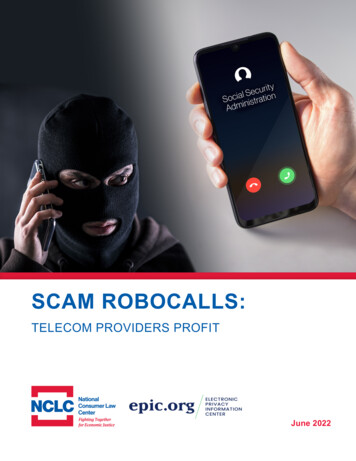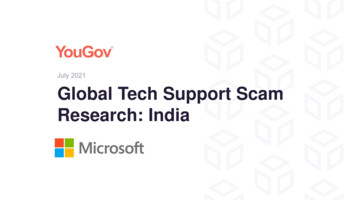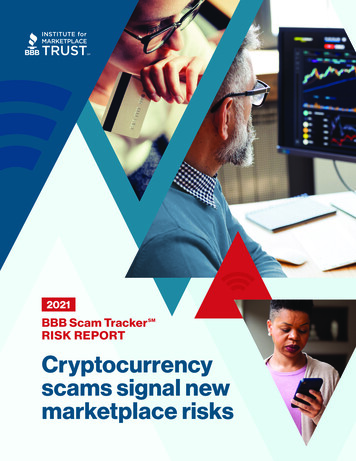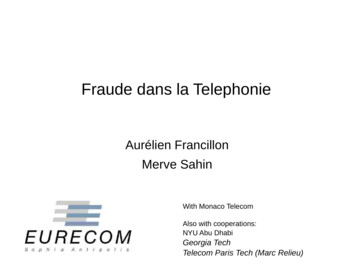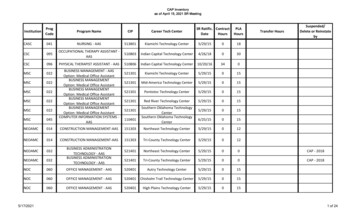
Transcription
Global Tech Support ScamResearchGlobal Summary, September 2018
The state of tech support scams in 2018 Consumers reduced their exposure and losses from tech support scams*: Over six-in-ten consumers experienced a techsupport scam down 5-points since 2016 driven by a decline in pop-up ads/windows, the most common type of tech support scam (49%).Scammers most often tricked consumers into downloading software (44%) or directing them to a specific website (34%). Fewerconsumers reported losing money directly as a result of the tech support scam; 6% vs. 9% in 2016.Tech support scams cause more than financial losses: An additional 8% of consumers who didn't directly lose money to scamsspent time and money checking and repairing their PCs. The combination of monetary and time losses produced high levels of stress as76% of consumers who encountered tech support scams said they suffered moderate to severe stress from the scam.Consumers were more suspicious of potential tech support scams: Heightened skepticism and distrust about potential techsupport scams contributed to better outcomes for consumers. 75% of consumers believed it highly unlikely that a reputable companywould initiate unsolicited contact and 83% would distrust that type of communication, up 12 and 17-points respectively. Only 41% ofconsumers who experienced a tech support scam would trust companies not to sell them unnecessary support or repair services. Overseven-in-ten consumers who experienced scams lost trust in software and technology companies ability to protect them from techsupport scams.Scammers most often requested consumers to download software or visit a specific website: Unfortunately,consumers took these two actions most often during a potential tech support scam interaction. In response to a hypothetical unsolicitedcontact, 38% reported they would try to block the company from contacting them while 33% would spent time researching the problem.Search engines (46%) and company websites (31%) were employed most often to learn and get help with tech support scams.Gen Z, Millennials and Males were the most vulnerable to tech support scams: These groups were the most likely to losemoney after continuing an interaction. They engaged in riskier online behavior such as visiting torrent sites, have a greater familiarity withtechnology companies than older generations and were potentially hurt by overconfidence in their device and Web expertise. Telephonetech support scams were the one area experienced more by Boomers/older consumers than by younger internet users.The future of tech support scams: This research suggests that both education and technology can play a role in reducingconsumer’s vulnerability to tech support scams. A 12-point drop in scammers asking for social security numbers (or their internationalequivalents) reflects the power of awareness building and education while increased adoption of ad-blocking technology in recent yearspotentially contributed to a significant decline in pop-up ads/windows scams.*A tech support scam is a phone call, email or online interaction which appears to be from a reputable company, claiming that your computer is infected with a virus2
Study overview Examines the incidence and consequences of tech support scams worldwide Web based survey of 16,048 adult internet users in 16 countries worldwide(1,000 per country) Sampled users 18 and older, proportional to internet user population.Equally divided between males and females* Updates a twelve country study done in 2016 Participating countries: (those added in 2018 shown in manyIndiaJapanMexicoNew ZealandSingaporeSouth AfricaSwitzerlandUnited KingdomUSA Changes seen in 2018 vs 2016 results remain consistent even if new geosare excluded*Within each country readable samples of Gen Z, Millennials, Gen X and Boomers were gathered.Worldwide sample is weighted 36% ages 18-34, 30% ages 35-49, and 34% ages 50 .Exact percentages in each geo reflect that nation’s internet population.3
Glossary of termsTypes of tech support scams Email: An unsolicited email that appears to be from a reputable company which claims that your computer is infected with a virus andthat they can help resolve the issue. Pop-Up: A pop-up window or advertisement online that appears to be from a reputable company which claims that your computer isinfected with a virus and that they can help resolve the issue. Phone: An unsolicited telephone call from someone claiming to be from a reputable company where the caller told you that yourcomputer may be infected with a virus or some other security or network problem, and that they can help resolve the issue. Redirect: Been redirected to a website that appears to be from a reputable company which claims that your computer is infected with avirus and that they can help resolve the issue.Types of actions taken after encountering a tech support scam Ignored the interaction completely Continued with the interaction: Continued with the interaction and took the recommended actions Initially continued with the interaction, but then did not take further actionOnline activities description Access my bank accounts and/or credit card accounts online Change passwords for email, social media and financial accounts Share my email address in exchange for access to website content Use a social media site (e.g., Facebook, Snapchat, Instagram, etc. ) Download the latest software updates shortly after they are made available Download movies, tv shows, music, other video Use torrent sites Buy products online (includes online auctions and classified ads)4
How pervasive are tech support scams today? The percentage of consumers whoreported experiencing a techsupport scam was 63%, down from68% in 2016. Fewer pop-upads/windows fueled the decline. Those who lost money directlyfrom a tech support scam fell 3points to 6%. Consumers successfully migratetheir response to tech supportscams from ignoring (-6) toavoiding the scam completely ( 5)potentially via increaseddeployment of pop-up ad-blockers. Scammers were successful intricking nearly one-in-fiveconsumers into continuing with apotentially fraudulent interactionabout the same as in 2016.Types of tech support scamsActions taken afterencountering a tech supportscam(Base: Experienced scam)30%37%27%36%Unsolicited call6%11%13%49%43%Redirect towebsiteUnsolicited email39%9%37%2016Q1a. Please indicate whether you have experienced any of the following in the last year or so (2017 and later).Q2. For each of the interactions you experienced, please indicate which actions you took44%2018Fewer pop-upads/windowsContinued, lostmoneyContinued,didn't losemoneyIgnoredPop-up ad orwindow49%Fewer lostmoney32%201637%2018No interactionMore avoidedscamcompletely5
Millennials, Males & Gen Z had the highest exposure to tech supportscamsTech Support Scam incidence by Age &GenderGen Z: 18-2353%35%Millennials: 24-3752%43%Gen X: 38-53Boomers: 54 MaleFemale43%36%48%43%Males were more likely to losemoneyMillennials were most likely tolose money25%27%9%10%7%33% 25%4%33% 31% 26% 32% 32% 24%Pop-up ad or windowUnsolicited emailRedirect to websiteUnsolicited callGen ZMillennialsGen XBoomersContinued, lost moneyContinued, lost moneyContinued, didn't lose moneyContinued, didn't lose moneyQ1a. Please indicate whether you have experienced any of the following in the last year or so (2017 and later).Q2. For each of the interactions you experienced, please indicate which actions you tookQ8. As a result of this interaction, have you lost any money?6
Tech support scams cause more than financial losses Among those who experienced ascam, 52% ended up spending timechecking and repairing their PC. Over three-in-four consumers whocontinued with a scam* reportedsuffering from moderate to severestress due to the fraudulentinteraction.Time spent checking & repairtheir PC (Base: experienced a scam)100%100%90%90%80%80%70%48%60%50%52% spent timechecking &40%repairing theirPC2%19%30%20%*That is, consumers who encountered a scam and at least initiallystarted doing what was asked/did not just ignore it. This is a mix ofthose who: Continued with the interaction and took the recommended actions Initially continued with the interaction, but then did not takefurther actionAmount of stress created bythe scam (Base: continued)10%0%30%Axis Title76% moderate tosevere stress32%Severe stress70%No time60% Week50%Week or less40% Few hours44%30%20%10%0%ModeratestressMild stressNo stress19%5%Axis TitleNew items in 2018Q12a. To date, how much time has it taken to fix or investigate further as to whether your computer had been compromised after this interaction?Q13. Thinking back on each interaction, how much stress did you suffer? If you had multiple interactions, think how you felt about the most stressful one. The most stressful interaction caused me 7
How are consumers fighting back against tech support scams? Consumers have developed ahealthy skepticism aboutunsolicited contact fromtechnology and softwarecompanies. Unsolicited contacthas become a red flag forconsumers that signals apotential scam. If faced with an unsolicitedcontact from a reputable techcompany, 38% of consumerswould try to block thatcompany from making contactin the future and 33% wouldlook up the issue online. 46% of consumers rely onsearch engines to research techsupport scams and 31% usecompany websites.Most believed companies would not initiateunsolicited contact (Base: Total)Most were distrustful of unsolicited contact(Base – 60%Very/Somewhatlikely40%20%0%2018Trust companies not to sell unnecessarysupport services(Base – experience any at likely22%13%3%Very likelyNew item in 201872% lost trust in companies ability toprotect people from scams (Base – experienceany scam)100%80%Very unlikelyDistrust a lot/notrust at allDistrust a little100%6%80%22%Lost all trust44%Lost a lot oftrustLost a little trust28%Did not lose anytrust60%40%Trust a lot/a little20%New item in 20180%in 2018New itemQ14. If you were to receive an unsolicited call or email like this from someone claiming to be from a reputable company offering you help, how likely would you be to trust them? Q15. How likely do you think it is that a reputable company would contact customerswithout first receiving some form of interaction from the customer? Q13b. How much do you trust software and technology companies not to sell you unnecessary support or repair services to fix new problems that are discovered on your computer? Q13c. Thinkingback on each interaction, how much trust have you lost in reputable companies like Apple, Facebook, Google and Microsoft to protect you from the types of interactions you experienced?8
Why are Gen Z, Millennials & Males more vulnerable to tech supportscams? Millennials and Gen Z engage inmore risky online activities thanolder generations that includedexchanging email for access tocontent, downloading movies, music,videos or using torrent sites. The youngest generations ratedthemselves highest on web andcomputer expertise suggesting thatoverconfidence in their onlineabilities could cause them to be lesscautious and thereby moresusceptible to scams. Millennials and Gen Z were found tobe more trusting than oldergenerations of reputable companiesmaking unsolicited contact. Greatertrust may result from a lack ofexperience or naivete as well asdiffering expectations among thosemore familiar with technologycompanies than older generations.Online activities (% almost always/often)72%69%Use social media39%Access bank, credit cardaccountsMillennials were most likely tobelieve unsolicited contact isnormal50%Gen Z30%70%Millennials33%67%37%43%Buy products online40%40%Timely download of softwareupdates25%28%Regularly change passwordsThose whocontinued & lostmoney engagedmore frequentlyin these activities32%30%Share email in exchange forcontent36%30%Download movie, music,videosBoomers17%16%Use Torrent sites0%20%40%Gen X60%80%Gen Z: 18-23Millennials:24-37Gen X:38-53Boomers: 54 New item in 2018Q15. How likely do you think it is that a reputable company would contact customers without first receiving some form of interaction from the customer?Q21a. Please check how often you do the following activities when you are online?22%18%78%82%Very/Somewhat likelyVery/Somewhat unlikely9
Impact of tech support scams by country 2016 & 2018*New in 20182016 (ranked by no interaction)0%20%Germany %10%United raliaSouth ny4%8%Singapore4%11%20%United Kingdom6%Global6%Brazil5%United States6%19%48%42%43%44%41%39%11%South 3%12%6%New 7%Continued -- lost moneyContinued - didn't loseContinued -- lost moneyContinued - didn't loseIgnoredNo interactionIgnoredNo interactionNote: Country percentages may not add to 100% due to roundingQ2. For each of the interactions you experienced, please indicate which actions you took, Q8. As a result of this interaction, have you lost any money?100%57%39%AustraliaMexico*80%65%Canada 3% 13%Denmark 7% 9%India60%29%France 4% 11%Switzerland*9% 11%37%46%0%Japan* 2%5%China9%43%12%9%100%45%57%United Kingdom 2% 8%Brazil20%51%7%80%49%19%16%Denmark 4%2%Singapore60%2018 (ranked by no interaction)29%27%22%10
Anatomy of tech support scamsScam exposure had costs beyond the initial loss of moneyNearly half ofthose continuingincurred a directeconomic cost6%Lost money to scam63%37%Exposed to ScamNo Interaction19%44%ContinuedIgnored scam3%5%Spent money onchecking & repairingInvested timechecking & repairing5%Nothing happenedThose who avoided direct scamlosses spend time and money onrepairs or to ensure their deviceswere not compromisedQ2. For each of the interactions you experienced, please indicate which actions you tookQ8. As a result of this interaction, have you lost any money?Q12. To date, how much money, if any, has it cost you to fix or investigate further as to whether your computer had been compromised after this interaction?Q12A. To date, how much time has it taken to fix or investigate further as to whether your computer had been compromised after this interaction?11
Rates of tech support scam loss became more consistent worldwide The worldwide decline inscam loss was driven bydeclines in countries thathad the highest rates ofloss in 2016, lead by India,U.S., China and Brazil. Conversely, countrieswhich had the lowestscam incidence in 2016(UK, Germany, Denmark)have regressed towardthe worldwide average. The U.S. was the singlegreatest ‘success story’,going from over two in 10suffering losses to only6%.Percent who Continued & Lost Money 2016-201822%21%16%2018SwitzerlandMexicoNew Zealand9%8%6%Japan2%12%14%9%Money lossincreased8%7%9%6%5%6%4%4%6%5%IndiaNew in ore Australia20164%4%3%4%CanadaFrance7%4%4%3%Denmark Germany6%2%UnitedKingdom2018Q1a. Please indicate whether you have experienced any of the following in the last year or so (2017 and later). Q2. For each of the items you experienced, please indicate whether you continued withthe interaction and took the recommended actions, initially continued but then did not take further action, or ignored the interaction. Q8. As a result of this interaction, have you lost any money?12
13
Country Snapshot AustraliaTypes of tech support scams5%7%50%6%11%Continued, lostmoneyUnsolicited call46%33%34%40%40%47%42%Redirect to website62%52%Pop-up ad orwindow26%31%201620189%No interactionMore avoidedscamcompletelyTech support scam incidence by age &genderMillennials: 24-3721%(Base: those who continued)73%69%76%52%IgnoredGen Z: 18-2379%Costs spread beyond monetary lossContinued, didn'tlose moneyUnsolicited emailPercent believing companies would notinitiate unsolicited contact fell91%Slightincrease inlosing moneyPossible scam outcomesGen X: 38-53Very/SomewhatunlikelyBoomers: 54 Very/SomewhatlikelyMaleFemale56%37%49%Spent timechecking/repairing PCAustraliaLevel of stress(Severe/Moderate)GlobalNew item in 2018Online activities (% almost always/often)40%66%61%Use social media48% 60%Access bank/credit card site52%46%38%31%37%29%38% 24%50%34%47%34% 29%46%39%Download latest updates33%39%39%Buy products online33%39%59%Change passwords regularly40%42%49%25%29%23%25%Share email in exchange for content29%23%Download movies, music, videosUse torrent sites13%14%Those whocontinued &lost moneyengaged morefrequently inthese activitiesPop-up ad or windowUnsolicited emailGen Z: 18-23Millennials:24-37Redirect to websiteUnsolicited callGen X:38-53Boomers: 54 New item in 201814
Country Snapshot BrazilTypes of tech support scams14%47%44%57%Possible scam outcomesUnsolicited call16%36%37%44%Redirect to website5%12%7%19%Most believed companies would notinitiate unsolicited contact28%34%2016201823%17%No interactionMore avoidedscamcompletely52%Gen X: 38-53Very/SomewhatunlikelyBoomers: 54 37%52%49%57%47%20%38% 13%37% 11%48%39%45% 18%42% 14%Spent timechecking/repairing PCBrazilLevel of stress(Severe/Moderate)GlobalNew item in 2018Online activities (% almost always/often)Tech support scam incidence by age &genderMillennials: 24-3783%76%IgnoredGen Z: 18-2377%82%69%Continued, didn'tlose moneyUnsolicited emailPop-up ad orwindow(Base: those who continued)Continued, lostmoney43%52%Costs spread beyond monetary lossFewer lostmoney19%81%78%Use social mediaAccess bank/credit card site40%49%Download latest updates47%48%Buy products onlineChange passwords regularlyShare email in exchange for content39%46%21%27%38%39%45%41%Download movies, music, videosUse torrent sites28%26%Those whocontinued &lost moneyengaged morefrequently inthese activitiesPop-up ad or windowUnsolicited emailGen Z: 18-23Millennials:24-37Redirect to websiteUnsolicited callGen X:38-53Boomers: 54 New item in 201815
Country Snapshot CanadaTypes of tech support scamsPossible scam outcomes3%13%4%10%38%38%40%39%39%50%48%Redirect to website51%61%Unsolicited emailPop-up ad orwindow33%25%20185%88%12%Continued, didn'tlose moneyNo interactionMore avoidedscamcompletelyTech support scam incidence by age &genderGen Z: 18-2395%(Base: those who continued)40%76%48%Ignored201688% believed companies would notinitiate unsolicited contactCosts spread beyond monetary loss77%Continued, lostmoneyUnsolicited call47%Slight decreasein losing money60%46% 49% 36%47% 38% 43% 32%Gen X: 38-5349% 39% 41% 36%Boomers: 54 Very/SomewhatlikelyMaleFemaleCanadaLevel of stress(Severe/Moderate)GlobalNew item in 2018Online activities (% almost always/often)70%69%Use social media42%Access bank, credit card accountsMillennials: 24-37Very/SomewhatunlikelySpent timechecking/repairing PC43% 36% 32% 45%57%43% 45% 40%39% 33% 34% 35%36%36%Buy products online38%34%Timely download of software updates28%24%Regularly change passwords23%32%Share email in exchange for content30%23%Download movie, music, videosUse Torrent sites62%16%13%Those whocontinued &lost moneyengaged morefrequently inthese activitiesPop-up ad or windowUnsolicited emailGen Z: 18-23Millennials:24-37Redirect to websiteUnsolicited callGen X:38-53Boomers: 54 New item in 201816
Country Snapshot ChinaTypes of tech support scamsPossible scam icited call19%Redirect to website20%15%31%No interactionMore avoidedscamcompletelyPop-up ad orwindow20162018Tech support scam incidence by age &genderMillennials: 24-3728%(Base: those who continued)77%71%76%52%Ignored57%45%69%Costs spread beyond monetary lossContinued, didn'tlose moneyGen Z: 18-2372%Continued, lostmoney19%Unsolicited emailMost believed companies would notinitiate unsolicited contactFewer lostmoneyGen X: 38-53Very/SomewhatunlikelyBoomers: 54 Very/SomewhatlikelyMaleFemale36%Spent timechecking/repairing PCChinaLevel of stress(Severe/Moderate)GlobalOnline activities (% almost always/often)56%60%Use social media19% 22% 20%16%Access bank/credit card site40%31%28%29% 18% 19%12%21% 11%10%9%37%23% 20% 15%27% 19% 21% 16%22%36%35%33%Download latest updates51%55%Buy products onlineChange passwords regularly12%20%Share email in exchange for content15%19%Download movies, tv shows, music,videosUse torrent sitesPop-up ad or windowUnsolicited emailRedirect to websiteNew item in 201842%52%15%17%Gen Z:18-23Millennials: 24-37Gen X: 38-53Boomers: 54 New item in 2018Those whocontinued &lost moneyengagedmorefrequently intheseactivities17
Country Snapshot DenmarkTypes of tech support scamsPossible scam outcomes4%37%Unsolicited call31%Redirect to website38%44%Unsolicited email42%43%Pop-up ad orwindow2016201827%24%Most believed companies would notinitiate unsolicited contact7%9%Continued, lostmoney57%52%8%16%(Base: those who continued)56%67%76%52%Continued, didn'tlose money37%32%20162018No interactionFewer avoidedscamcompletelyTech support scam incidence by age &genderMillennials: 24-3792%Costs spread beyond monetary lossIgnoredGen Z: 18-2384%More lostmoneyGen X: 38-53Very/SomewhatunlikelyBoomers: 54 Very/SomewhatlikelyMaleFemale56%43%43%Spent timechecking/repairing PCDenmarkLevel of stress(Severe/Moderate)GlobalNew item in 2018Online activities (% almost always/often)31%62%73%Use social media49%43%Access bank/credit card site52%43%30%48%37%51%49%42%29%39%36%34% 21% 38%49%38%39% 24% 34%41%33%29%Buy products onlineChange passwords regularly24%23%Share email in exchange for content25%24%Download movies, tv shows, music,videosUse torrent sitesPop-up ad or windowUnsolicited emailRedirect to website39%43%Download latest updates23%31%16%15%Those whocontinued &lost moneyengaged morefrequently inthese activitiesGen Z:18-23Millennials: 24-37Gen X: 38-53Boomers: 54 New item in 201818
Country Snapshot FranceTypes of tech support scamsPossible scam outcomes17%17%29%33%37%34%43%45%51%Redirect to websitePop-up ad orwindow12%76%52%Ignored43%41%No interactionTech support scam incidence by age &gender58%Spent timechecking/repairing PCFrance2018Gen Z: 18-234%48%78%Continued, didn'tlose moneyUnsolicited emailMost believed companies would notinitiate unsolicited contact88%Continued, lostmoney44%201696%(Base: those who continued)4%11%4%Unsolicited callCosts spread beyond monetary loss35%52%GlobalNew item in 2018Online activities (% almost always/often)25%70%68%Use social media55%63%Access bank/credit card siteMillennials: 24-3749%Gen X: 38-5344%32% 28%13%Very/SomewhatunlikelyBuy products onlineBoomers: 54 40%32% 29% 15%Change passwords regularlyVery/SomewhatlikelyMaleFemaleLevel of stress(Severe/Moderate)53%37%38%38%38% 19%37% 19%30% 29% 15%43%47%24%26%40%33%Share email in exchange for contentDownload movies, tv shows, music,videosUse torrent sitesPop-up ad or windowUnsolicited emailRedirect to website37% 52%Download latest updates22%20%13%14%Those whocontinued &lost moneyengaged morefrequently inthese activitiesGen Z:18-23Millennials: 24-37Gen X: 38-53Boomers: 54 New item in 201819
Country Snapshot GermanyTypes of tech support scamsPossible scam outcomes3%4%Unsolicited call12%23%35%32%16%26%34%34%4%8%44%Redirect to websitePop-up ad orwindow49%48%80%76%52%48%No interactionTech support scam incidence by age &genderGen X: 38-53Very/SomewhatunlikelyBoomers: 54 Very/SomewhatlikelyMaleFemale53%Spent timechecking/repairing PCGermany2018Millennials: 24-3711%(Base: those who continued)IgnoredGen Z: 18-238%Costs spread beyond monetary lossContinued, didn'tlose moneyUnsolicited emailMost believed companies would notinitiate unsolicited contact89%Continued, lostmoney39%201692%Slightincrease inlosing money38%48%24%Level of stress(Severe/Moderate)GlobalOnline activities (% almost always/often)54% 65%Use social media27%36%Access bank, credit card accounts44%31%39%30% 16%34% 23%16%24% 30% 20%14%40%41%32% 21%27% 28% 20%11%31%41%Buy products online37%47%Timely download of software updates22%24%Regularly change passwords22% 34%Share email in exchange for contentDownload movie, music, videosUse Torrent sitesPop-up ad or windowUnsolicited emailRedirect to websiteNew item in 201818%15%13%14%Those whocontinued &lost moneyengaged morefrequently inthese activitiesGen Z:18-23Millennials: 24-37Gen X: 38-53Boomers: 54 New item in 201820
Country Snapshot IndiaTypes of tech support scams30%56%49%63%Possible scam outcomes14%22%24%Unsolicited call48%Redirect to website44%Unsolicited email56%Pop-up ad orwindow38%32%28%Continued, didn'tlose moneyCosts spread beyond monetary loss(Base: those who continued)84%71%76%52%Ignored32%20%No interactionMore avoidedscamcompletely2018Tech support scam incidence by age &genderMillennials: 24-3768%Continued, lostmoney26%Gen Z: 18-2362%26%32%2016Most believed companies would notinitiate unsolicited contactFewer lostmoneyGen X: 38-53Very/SomewhatunlikelyBoomers: 54 Very/SomewhatlikelyMaleFemale60%42%60% 23%Spent timechecking/repairing PCIndiaLevel of stress(Severe/Moderate)GlobalOnline activities (% almost always/often)53%56% 29%54% 41% 41%20%37% 33% 35%18%57%49%50% 23%54% 40% 46% 23%43% 59%48%48%Buy products online58%60%Timely download of software updatesRegularly change passwordsShare email in exchange for content43%48%40%46%57%54%Download movie, music, videosUse Torrent sitesPop-up ad or windowUnsolicited emailRedirect to website75%78%Use social mediaAccess bank, credit card accounts64%New item in 201832%28%Gen Z:18-23Millennials: 24-37Gen X: 38-53Boomers: 54 New item in 2018Those whocontinued &lost moneyengaged morefrequently inthese activities21
Country Snapshot JapanTypes of tech support scamsPossible scam outcomes2%5%6%13%36%37%44%GlobalRedirect to website27%19%18%30%JapanMost believed companies would notinitiate unsolicited contact17%90%37%No interactionGlobalMore avoidedscamcompletelyJapanTech support scam incidence by age &gender10%17%Gen X: 38-5334%20%Very/SomewhatlikelyMaleFemaleSpent timechecking/repairing PCGlobal26%34%25%18%Level of stress(Severe/Moderate)JapanNew item in 201853%61%Use social mediaAccess bank/credit card site34%Boomers: 54 40%Online activities (% almost always/often)18% 13% 14% 6%Millennials: 24-37Very/Somewhatunlikely52%76% 80%Ignored65%Gen Z: 18-2383%(Base: those who continued)Continued, didn'tlose money43%Unsolicited emailPop-up ad orwindowCosts spread beyond monetary lossContinued, lostmoney29%Unsolicited call27%Fewer lostmoney23%9%22% 6%15% 6%22%25%14% 13%4%29%37%36%Download latest updates28%Buy products onlineChange passwords regularly10%13%46%12%14%Share email in exchange for contentDownload movies, music, videosUse torrent sites24%29%19%21%16%16%Those whocontinued &lost moneyengaged morefrequently inthese activitiesPop-up ad or windowUnsolicited emailGen Z: 18-23Millennials:24-37Redirect to websiteUnsolicited callGen X:38-53Boomers: 54 New item in 201822
Country Snapshot MexicoTypes of tech support scams22%27%36%37%44%Global53%Possible scam outcomes6%14%8%42%Unsolicited email62%Pop-up ad orwindowMexico43%37%17%Global19%MexicoNo interaction27%Fewer avoidedscamcompletelyMexicoTech support scam incidence by age &genderMillennials: 24-3781%Costs spread beyond monetary loss(Base: those who continued)70%76% 78%52%IgnoredGen Z: 18-2383%Continued, didn'tlose money46%GlobalMost believed companies would notinitiate unsolicited contactContinued, lostmoney19%Unsolicited callRedirect to websiteMore lostmoneyGen X: 38-53Very/SomewhatunlikelyBoomers: 54 Very/SomewhatlikelyMaleFemale67%34%62% 19%Spent timechecking/repairing PCGlobalLevel of stress(Severe/Moderate)MexicoOnline activities (% almost always/often)82%81%Use social media33%44%Access bank/credit card site68%50%58%45%60% 22%52% 16%43% 30% 34%12%66%54%51%58% 22%33% 48% 14%New item in 2018Download latest updates30%37%Buy products online36%36%Change passwords regularly34%34%Share email in exchange for content35%32%Download movies, music, videosUse torrent sites13%14%16%16%Those whocontinued &lost moneyengaged morefrequently inthese activitiesPop-up ad or windowUnsolicited emailGen Z: 18-23Millennials:24-37Redirect to websiteUnsolicited callGen X:38-53Boomers: 54 New item in 201823
Country Snapshot New ZealandTypes of tech support scams22%27%36%37%44%Global53%Possible scam outcomes6%14%6%15%42%Unsolicited email62%Pop-up ad orwindowNew Zealand43%37%Global10%New ZealandNo interaction22%New ZealandFewest WWavoided scamcompletelyTech support scam incidence by age &genderMillennials: 24-3717%Costs spread beyond monetary loss(Base: those who continued)52%76%67%40%IgnoredGen Z: 18-2390%Continued, didn'tlose money57%GlobalMost believed companies would notinitiate unsolicited contact83%Continued, lostmoneyUnsolicited callRedirect to websiteMatch WWaverageGen X: 38-53Very/SomewhatunlikelyBoomers: 54 Very/SomewhatlikelyMaleFemale59%40%56%48%Spent timechecking/repairing PCGlobalLevel of stress(Severe/Moderate)New ZealandNew item in 2018Online activities (% almost always/often)71%71%Use social media58%58%Access bank/credit card site56%46%44%49%38% 38% 27% 49%34% 35% 23%51%43%38%Buy products online68%42% 40%37%46%Download latest updatesChange passwords regularly55%39% 38% 28% 54%30%27%Share email in exchange for content34%27%Download movies, music, videos25%33%Use torrent sites16%17%Those whocontinued &lost moneyengaged morefrequently inthese activitiesPop-up ad or windowUnsolicited emailGen Z: 18-23Millennials:24-37Redirect to websiteUnsolicited callGen X:38-53Boomers: 54 New item in 201824
Country Snapshot SingaporeTypes of tech support scams43%52%20%37%35%43%Redirect to website42%46%Pop-up ad orwindow16%(Base: those who continued)50%81%76%52%Ignored43%35%No interactionMore avoidedscamcompletely2018Tech support scam incidence by age &genderGen Z: 18-2384%Costs sprea
2 Consumers reduced their exposure and losses from tech support scams*: Over six -in ten consumers experienced a tech support scam down 5-points since 2016 driven by a decline in pop-up ads/windows, the most common type of tech support scam (49%). Scammers most often tricked consumers into downloading software (44%) or directing them to a specific website (34%).

